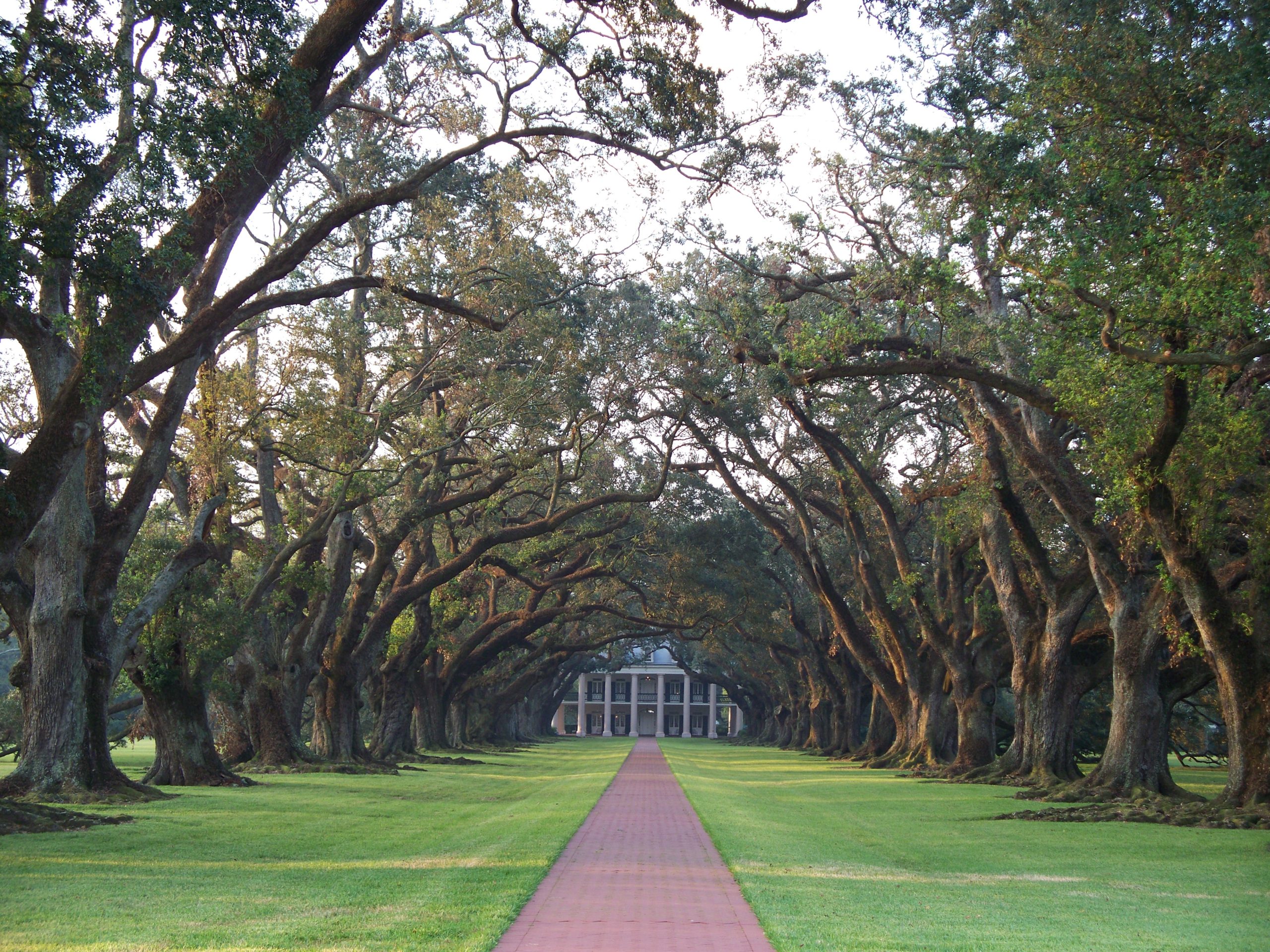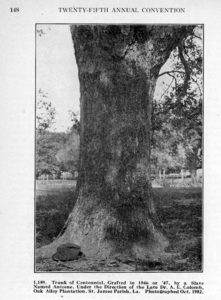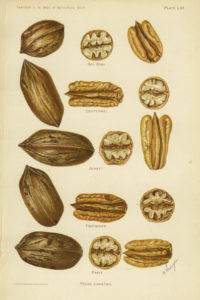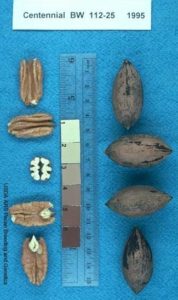The beginning of modern pecan culture

View of Oak Alley Plantation through the “alley” leading from the house to the Mississippi River. (Photo contributed by Oak Alley Foundation, Vacherie, Louisiana)
Very little is known about Antoine, other than the fact that he was an enslaved gardener at Oak Alley Plantation. His mother Zaire was born in slavery in Louisiana1, but his father Zephyr had been kidnapped from the African Congo and enslaved.2
The best and most complete story of his grafting of the pecan was told by W.A. Taylor, who wrote of it in his article “Promising New Fruits,” published in the 1904 Yearbook of the U.S. Department of Agriculture. As I cannot improve upon it, I will include it here:
The original tree of this variety stood on the Anita plantation of Mr. Amant Bourgeois, on the east bank of the Mississippi River, in St. James Parish, Louisiana, from some date early in the nineteenth century until March 14, 1890, when it was destroyed by the disastrous Anita crevasse, which swept away, to a depth of 15 feet, the earth in which it stood. Whether it was a chance seedling or was grown from a planted nut is not known. So far as known, the first effort to perpetuate the variety by grafting was made by the late Dr. A.E. Colomb early in the [1840s]. Not succeeding in this effort, Dr. Colomb later cut scions from the original tree and took them to the late Telesphore J. Roman, owner of Oak Alley plantation, on the [west] bank of the river, whose slave gardener, Antoine by name, succeeded in grafting 16 trees near the mansion and quarters with this variety in the winter of 1846 or 1847. Somewhat later than this Mr. Roman had 110 trees grafted “in the large pasture which was forty arpents from the river” with the same variety, so that by the close of the Civil War (1865) there were 126 grafted ‘Centennial’ trees in bearing on this plantation. The plantation having changed hands shortly after the war, the later plantings of grafted trees were cut down to make way for sugar cane, although they were just reaching their most productive age and the nuts from them were then selling at from $50 to $75 per barrel.
In 1876, Hubert Bonzano, who then owned Oak Alley, exhibited nuts from these grafted trees at the Centennial Exposition in Philadelphia. He was awarded a diploma based upon an examination by Prof. William H. Brewer, in which the variety was commended for its “remarkably large size, tenderness of shell, and very special excellence”.
It is not clear as to who first applied the name Centennial to the variety, but so far as ascertained it was first catalogued under that name by the late Richard Frotscher of New Orleans, in 1885. The propagation of budded and grafted trees of [‘Centennial’] for sale…[began] about 1882 by William Nelson, who was associated with Mr. Frotscher in the pecan nursery business.

Trunk of a ‘Centennial’ pecan tree at Oak Alley, photographed in 1904. (Photo by W.A. Taylor, 1904, National Agricultural Library Digital Collections)
So far as ascertained, the ‘Centennial’ is the first variety of pecan that was successfully propagated by…grafting. It was also the first variety planted in commercial orchard form, with a definite view to producing nuts for sale, and one of the first three to be catalogued and offered for sale.
Two of the earliest grafted ‘Centennial’ trees, referred to above, are still standing at Oak Alley. They were thrifty, productive, and in fine condition when inspected by the writer in the autumn of 1902. The date of their grafting by the slave Antoine (1846 or 1847) under Dr. Colomb’s direction, marks the beginning of modern pecan culture.
Size large, average nuts running about 45 to 50 to the pound; form long, compressed cylindrical, gradually tapering to the wedge-shaped apex; base conical; color bright grayish brown with rather scanty purplish splashes toward the apex; shell rather thick, partitions thin; cracking quality medium; kernel clear, reddish yellow, deeply and narrowly grooved, but quite smooth and separating easily from the shell; plump, solid; of delicate texture and flavor, quality very good.
The ‘Centennial’ tree is a rather slender grower with grayish green young wood sprinkled with small light dots. It becomes pendulous as it attains age, and is on this account one of the handsomest varieties for parks or large lawns. It is slow to come into bearing, but appears to be a fairly regular cropper after attaining an age of about 15 years from bud or graft.
The specimens illustrated on Plate LVI were from one of the two surviving trees that were grafted in 1846-47 on Oak Alley plantation, Feitel [now Vacherie], St. James Parish, Louisiana. They were furnished by the present owner of the plantation, Mr. A.M. Sobral.3
In June 2019, I attended a very interesting lecture by Dr. L.J. Grauke at the 2019 TriState ArkLaMiss Pecanference. Dr. Grauke has since retired, but at the time, he was a Research Horticulturist at the USDA Agricultural Research Service Pecan Breeding and Genetics program in College Station, Texas. This program not only maintains a database of pecan genetics but also preserves numerous specimen trees at one of their two locations in Texas.

U.S. pecan varieties. ‘Centennial’ is second from the top. (Photo by U.S. Department of Agriculture Yearbook)
At the 2019 conference, I asked Dr. Grauke whether it was possible to obtain scions of the ‘Centennial’ variety, and he promptly answered in the affirmative! I then coordinated with Sam Pollard of Texas Pecan Nursery in Chandler, Texas. Sam agreed to receive my ‘Centennial’ scions and graft them onto rootstock in his nursery.
In January 2021, I heard from Sam that he had received ten scions and had successfully grafted seven of them. He shipped the trees to my office in our family orchards just in time for The Big Polar Vortex of 2021! I actually moved them inside for the week of the subfreezing weather, not wanting to take any chances on them freezing to death.
Next came the decisions regarding where to plant these seven specimens. On a whim, I emailed the office of Oak Alley Plantation and described what I had. Knowing from Taylor’s article that by 1902 only two of the original grafted trees were left and the original tree at Anita Plantation had been washed away, I asked whether they had any of the original grafted trees remaining at Oak Alley.
I received a prompt reply from Vince Yardas, the Director of Research and Interpretation. He told me that they did not have any of the original trees. He related that about ten years ago they purchased some ‘Forkert’ pecan trees from Texas Pecan Nursery and planted them as representatives of modern improved varieties. They used these trees as examples to refer to when they discussed Antoine’s contributions in their historical tours. He admitted that they would be thrilled to have trees genetically identical to Antoine’s trees.
Mr. Yardas and Doug Pitre, Oak Alley’s Director of Grounds and Maintenance, drove up in mid-June to take possession of three ‘Centennial’ trees, donated by me on behalf of the Louisiana Pecan Growers Association.
I have also promised to donate two trees to the Louisiana State University of Alexandria, where pecan horticulturist Dr. Michael Polozola promises to plant them in conspicuous locations. I plan to plant two here at my family orchards on a part of what was long ago Rosalie Plantation just south of Alexandria.
We are making plans for dedications of these three plantings at future dates.
One question that might occur to the reader, especially to a pecan grower, is “Why did the ‘Centennial’ cultivar not remain popular?” The answer to that can be found in Dr. Grauke’s description:
Nut: oblong with acute apex and acute base; round in cross section; 70 nuts/lb, 45% kernel; kernels golden in color, dorsal grooves narrow near apex, flared at base, with prominent secondary grooves. Protandrous. Very slow to bear, low production. Discounted for use in 1913 (Reed, Proc. Nat. Nut Growers Assoc. 12:52): “Variety too tardy and shy in bearing to be recommended for any locality.”4
1Zaire, Slavery Database, Oak Alley Plantation website, accessed 14 Jun 2021.
2Zephyr, Slavery Database, Oak Alley Plantation website, accessed 14 Jun 2021.
3Taylor, W. A. Promising New Fruits, 1904 Yearbook of the Department of Agriculture, 1905, accessed 12 Jun 2021.
4Grauke, L. J. Centennial, National Collection of Genetic Resources for Pecans and Hickories, accessed 13 Jun 2021.


